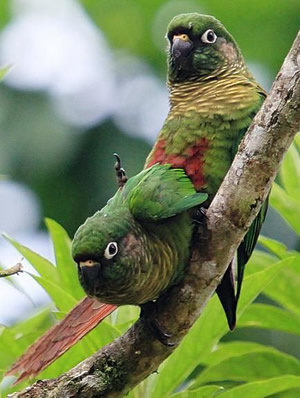Species Description
It has been suggested that the Maroon-bellied Parakeet should include the Blaze-winged Parakeet (P. devillei) as a subspecies based on intermediate specimens from Paraguay. But such hybrids are not common in the wild and the two populations generally maintain their integrity; they are therefore generally considered separate species today.
Another subspecies, kriegi, was described from Bahia in 1932, but today it is universally considered a junior synonym of the nominate subspecies. Distinguished by a narrow brownish-red tip to the tail, it consititutes just a morph or an intermediate genotype making up just 20% of the specimens even in the supposed range. The name Krieg's Conure is occasionally used in aviculture for such birds, and some breed them exclusively; they are of course perfectly interfertile with individuals of the normal morph however.
These birds range from 10- to 11 inches (c.25-28 cm), and are primarily green, with a maroon patch on the belly, a "scaly" yellow-green-barred breast and sides of neck, a whitish ear-patch often tinged brown, and a maroon undertail. The specific name frontalis is a reference to its dark maroon frontlet - a feature which separates it from most similar species. The primaries are blue on the outer webs, green on the inner webs, and dark on the tips. The beak is black.
Habitat
The Maroon-bellied Parakeet is common in woodland, and forest edges. In the northern part of its range, it mainly lives in highlands up to 4,600 ft (1,400 m), but elsewhere it is primarily found in lowlands up to (3,300 ft (1,000 m). Tolerates disturbance well and even lives in urban parks (e.g., Rio de Janeiro and Sao Paulo) and feeds in gardens. Flock size is usually only 6-12 individuals, but up to 40. As other members of the genus Pyrrhura, it primarily feeds on fruits, flowers, and similar plant matter.
Distribution
This small parrot is found from Southeastern Brazil through Northern Argentina, including Paraguay and Uruguay and maybe the Eastern tip of Bolivia.






